Just looking for our Best Roofing Website examples list?
Why Your Roofing Website Design Matters More Than You Think
When homeowners search for roofing contractors, their first impression usually comes from one place: your website. Within seconds, they decide if your roofing company looks credible, professional, and capable of solving their problem. A poorly designed roofing site doesn’t just look outdated—it actively drives potential customers away.
Your roofing website isn’t just a digital business card. It’s your most powerful sales rep, working around the clock to turn local searchers into booked jobs. Whether someone is urgently seeking a new roofing estimate or comparing roofing contractors in their area, your site needs to load quickly, build trust instantly, and guide them toward action.
That’s why great design isn’t optional—it’s essential. A high-performing roofing company website impacts your bottom line by attracting better leads, increasing conversions, and ranking higher in local searches. If your site isn’t optimized for mobile, lacks clear calls to action like your phone number or a free estimate, or doesn’t showcase why you’re the best roofing option, you’re losing business to more polished competitors.
In this guide, we’ll break down the key elements that separate the best roofing websites from the rest, so you can ensure your website drives real results for your roofing business. From intuitive layouts and conversion-focused copy to local SEO tips and the best roofing website design inspiration, we’ll show you exactly how to build a website that works just as hard as you do.
Website Planning & Purpose: Laying the Groundwork for a Profitable Website
Before you dive into layouts, color schemes, or imagery, step one in any website design project is to plan with purpose. Too often, roofing contractors jump straight into building a website without asking the most important question: What should this site actually accomplish?
In the roofing industry, a well-planned website isn’t just about aesthetics. It’s about function. A successful roofing site should act as a lead-generating machine, clearly communicating your services, showcasing your credibility, and making it effortless for prospects to request a quote or call your team. Without a clear structure and defined goals, your site risks becoming a digital brochure that sits idle rather than a conversion-focused asset.
The planning phase should start with identifying your target audience and their top priorities. Are you serving residential or commercial clients? Are most leads coming from mobile devices? Do customers look for specific services like storm damage repair or gutter installation? These answers will shape your site architecture and content strategy.
It’s also essential to define your website’s primary calls to action. Do you want users to call your office, fill out a contact form, or request a free estimate? These decisions inform everything from the homepage layout to button placement and page hierarchy. At every step, the goal should be to reduce friction and guide users toward action.
Additionally, planning should account for local SEO strategy. This means incorporating location pages for service areas, schema markup for reviews, and a logical URL structure that improves search visibility.
For a deeper look into strategy and inspiration, check out our breakdown of what makes a strong roofing website here: Roofing Website Design
Great design follows great planning. Without it, even the best-looking websites will fall flat. Taking time upfront to clarify your goals, audience, and conversion paths ensures your website performs as hard as your crew does on every job.
Design Principles: What Makes a Website Stand Out
In a highly competitive industry like this, first impressions matter—and your website design is your first shot at earning trust. A great roofing company website should reflect professionalism, confidence, and clarity. If your design feels cluttered, outdated, or generic, potential clients are likely to click away and call the next roofer on the list.
The first and most important principle is simplicity. Visitors should immediately understand what you do and how to take the next step. Clear headlines, clean navigation, and prominent calls to action—like “Request a Free Estimate” or your company phone number—help guide users quickly and intuitively.
Mobile responsiveness is non-negotiable. Most roofing leads start from a phone, especially in urgent scenarios. Your site needs to load quickly, look great on every screen size, and make it easy to tap a number or form without pinch-zooming or scrolling endlessly.
Visual hierarchy is another critical component. Lead with your most valuable content—services, credibility markers, and trust-building visuals like client reviews or completed roofing projects. Use larger fonts for key messages, bold callout sections for estimates, and whitespace to make content easier to scan.
Trust signals also need to be front and center. This includes licenses, certifications, BBB ratings, local awards, and client testimonials. High-resolution images of actual roofing jobs—not stock photos—help differentiate your company and show real, local expertise.
Finally, design must integrate with content strategy. Every visual element should support the story you’re telling. Whether you’re creating a homepage, service page, or a roofing social media post, consistency across your branding reinforces trust and strengthens recall.
A clean, fast, user-friendly design doesn’t just look good—it converts. Applying these core principles ensures that every visitor to your roofing website has a seamless experience that builds trust and encourages them to reach out.
Content & Navigation: Structuring Your Site for Clarity and Conversions
Your website content and navigation structure are not just about aesthetics—they directly impact whether visitors stay, explore, and contact your roofing business. Poor navigation confuses users, while scattered content dilutes your message. For roofing companies, a clear structure is critical for capturing and converting local leads.
Begin with a well-organized top navigation bar that limits choices and prioritizes the most important pages: Home, Services, About, Gallery/Projects, Reviews, and Contact. If you offer multiple roofing services—such as residential roofing, commercial roofing, roof repair, and inspections—create individual service pages. This improves clarity for visitors and creates additional opportunities for SEO targeting.
Each page should be built with intent. For example, your homepage should establish credibility quickly, highlight core services, and make it easy to take the next step with a call button or free estimate form. Service pages should include local keywords, customer testimonials, photos of past jobs, and answers to common client questions. These elements support trust, enhance local relevance, and encourage deeper site exploration.
Content must be scannable. Use short paragraphs, bolded subheadings, and bullet points to break up text. Include clear calls to action—like “Request a Free Estimate” or “Call Our Roofing Experts Today”—on every page.
It’s also vital to make your phone number visible in the header, include contact forms on key pages, and ensure navigation is consistent across mobile and desktop.
Most importantly, align your content strategy with what actually converts. We’ve detailed 15 high-performing content elements for contractors in our in-depth guide: 15 Converting Elements Every Contractor Needs in 2025
When navigation is intuitive and content is designed to answer the buyer’s questions, your website becomes a trusted resource, not just a brochure. This structure builds trust, improves SEO, and most importantly, increases the number of qualified leads your roofing business receives.
Visual Elements: Building Trust and Driving Action Through Design
In roofing web design, visuals are far more than decoration—they’re powerful tools for building trust, conveying professionalism, and helping potential customers envision the results of your services. A well-designed website uses images, layout, and branding to create a seamless experience that guides users toward action while reinforcing your credibility.
First and foremost, always use high-quality images of completed roofing projects. These real examples of your work speak louder than any block of text. Before-and-after photos, drone shots, and images of your crew in the field all help build trust and give prospects the confidence that you can handle their job.
Visual hierarchy is another essential element. Use layout and color contrast to guide users’ eyes to the most important content, like your phone number, service options, or a call-to-action button. For example, placing a bold “Request a Free Estimate” button near the top of your homepage ensures it’s one of the first things seen by website visitors.
Your visual identity should also reflect your brand. Consistent use of color palettes, logo placement, and typography reinforces who you are. Whether you’re designing your roofing website from scratch or upgrading an outdated layout, the visual language should be unified across every page.
Don’t forget that mobile visuals matter just as much as desktop. A professional roofing website must look clean and function flawlessly on every device. This includes optimized image sizes for fast loading and design elements that scale effectively on smaller screens.
Finally, your visuals should complement—not compete with—your messaging. Every image and design choice should support the story your content is telling. When visuals and content work together, they make your roofing website easy to navigate, trustworthy to browse, and powerful at converting visitors into leads for your roofing business.
In the end, an effective roofing website isn’t just visually appealing—it’s purposeful. Strong visuals help potential clients picture working with you, reinforce your expertise, and ensure that your roofing company stands out in a crowded market.
Ongoing WordPress Maintenance: Protecting Your Investment
Once your website is live, the work isn’t over. In fact, one of the biggest mistakes roofing companies make is assuming that launching the site is the finish line. Without regular updates and proactive maintenance, even the most professional WordPress website can quickly become slow, insecure, or broken, costing you leads and credibility.
For roofing companies, ongoing WordPress maintenance isn’t optional. It’s a critical part of protecting your digital presence and ensuring your site continues to perform. WordPress regularly releases core updates to improve functionality and patch vulnerabilities. Ignoring these updates puts your site at risk for security breaches, compatibility issues, and performance degradation.
Themes and plugins—many of which power contact forms, galleries, or mobile responsiveness—also require frequent updates. An outdated plugin can cause site errors, slow down loading speeds, or open the door to cyber threats. Regular maintenance ensures these components stay in sync and your site remains stable and fast.
Another key piece of maintenance is backups and uptime monitoring. Roofing leads often come through your site outside of business hours. If your website goes down unexpectedly, even for a few hours, that could mean lost revenue. A reliable maintenance plan includes daily backups and tools that alert you to any downtime or issues before they impact your customers.
Don’t overlook performance optimization. Over time, unused images, old plugins, or bloated databases can slow your site. Regular maintenance keeps things lean, ensuring pages load quickly for both users and search engines—an essential part of effective roofing SEO.
Just like a roof needs inspections and occasional repairs to stay functional, your roofing website needs consistent attention. Ongoing WordPress maintenance keeps your digital storefront protected, optimized, and ready to generate leads long after launch. For a business built on reputation and reliability, maintaining your website should be treated with the same level of professionalism as every job you complete in the field.
Best Roofing Website Design Examples
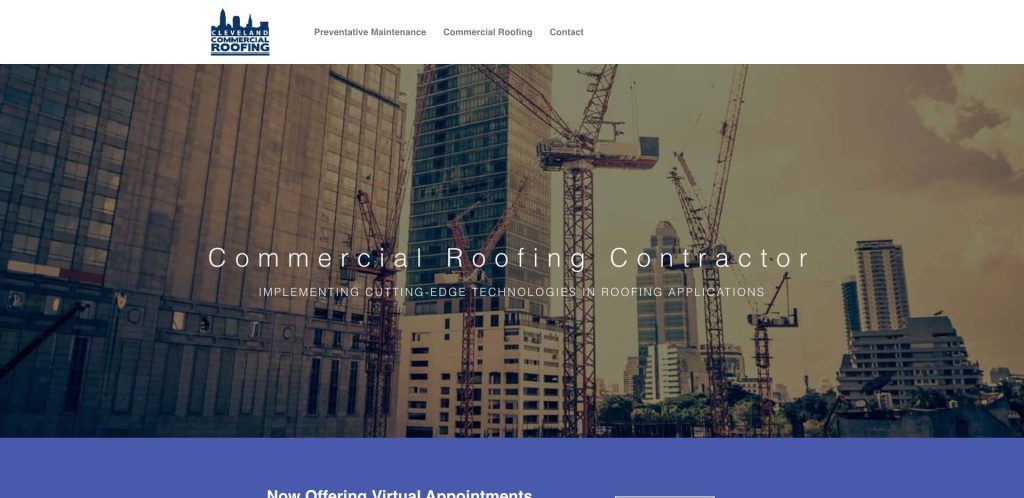
1. Cleveland Commercial Roofing
Location: Cleveland, OH
- Sleek, streamlined homepage with major service highlights above the fold
- Persistent contact form and prominent CTA for instant lead capture
- Consistent visual branding reinforces trust and clarity
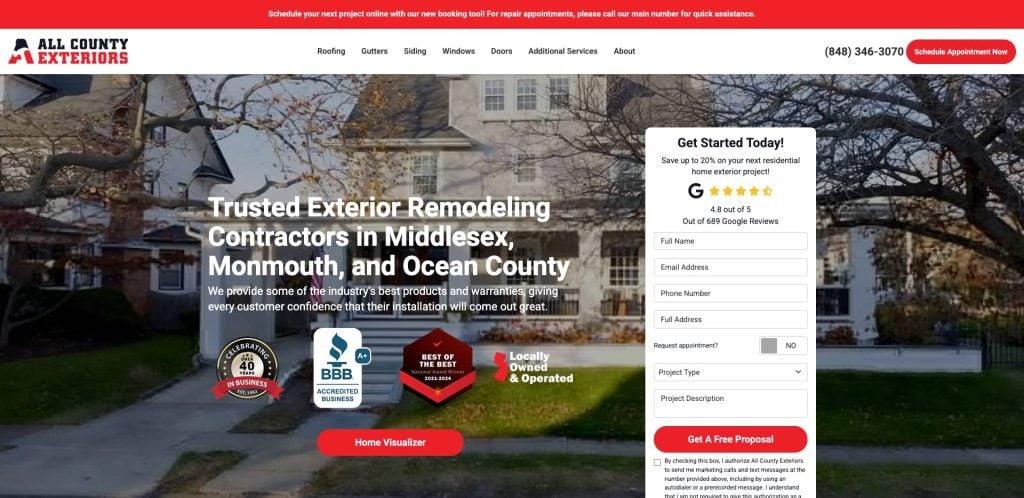
2. All County Exteriors
Location: New Jersey (statewide)
- Highlights experience with trust badge (40 years) front‑and‑center
- Interactive project map lets visitors explore completed jobs
- Strong testimonials + organized services section build credibility
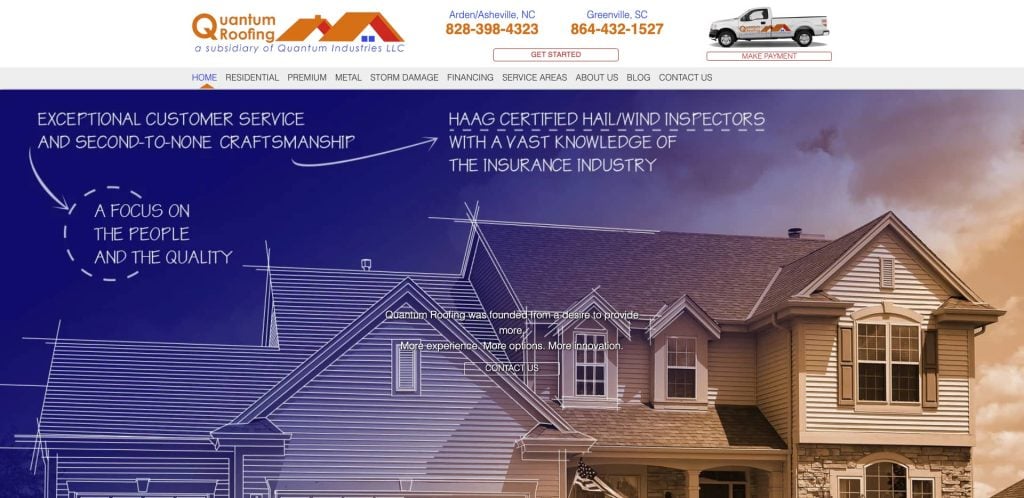
3. Quantum Roofing
Location: U.S. (multi‑region)
- Simplified horizontal menu with essential links and actions
- CTA buttons like “Get Started” and “Make Payment” reduce friction
- Phone number prominently displayed for immediate contact
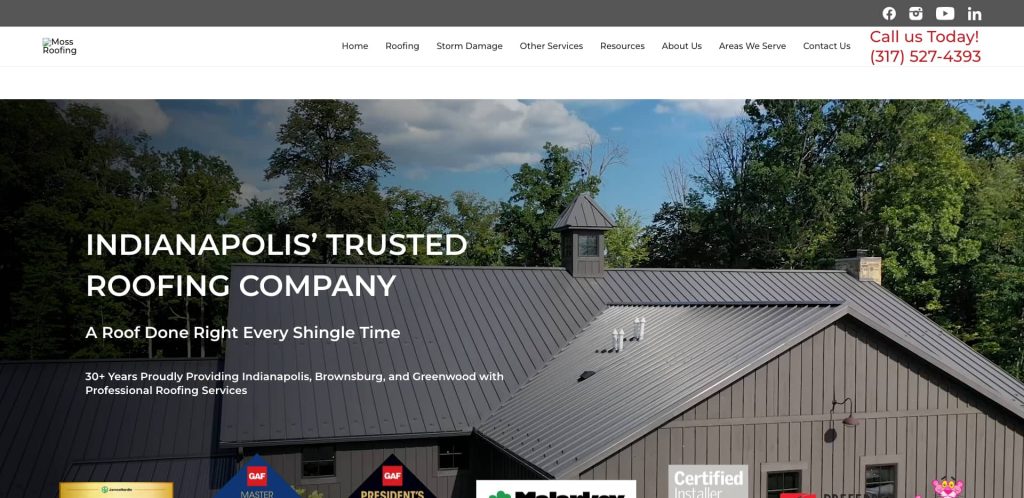
4. Moss Roofing
Location: Multiple U.S. regions
- Includes chatbot feature and clear navigation for lead capture
- Limited color palette and review integration boost trust
- Blog presence and virtual inspection features reduce friction
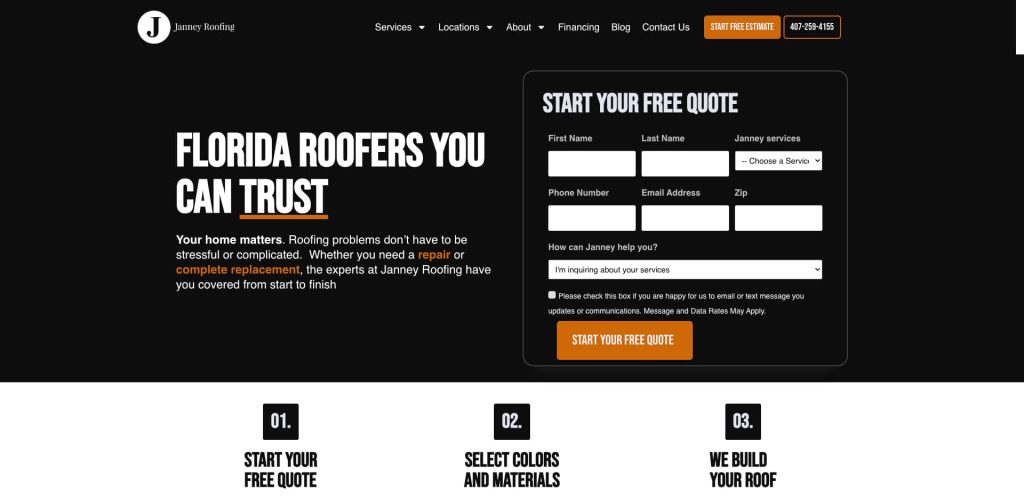
5. Janney Roofing
Location: Likely Northeast U.S.
- Hero video slider gives behind‑the‑scenes insight into the process
- Rounded CTAs and clean icons elevate visual professionalism
- Minimalist interface guides users toward the lead form
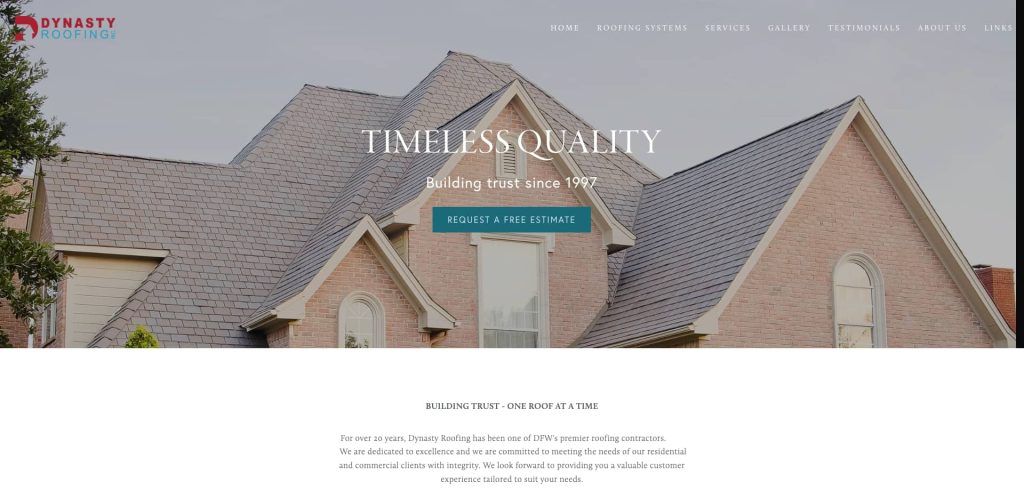
6. Dynasty Roofing Inc.
Location: Dallas–Fort Worth, TX
- Clear hero CTA (“Request A Free Estimate”) front and center
- Mega navigation bar groups content logically for effortless browsing
- High‑quality images and videos enhance brand presence and trust

7. Houston Roofing & Construction
Location: Houston, TX
- Organized navigation groups’ multi‑service offerings clearly
- Simple menu structure improves usability and clarity
- Local targeting is built into the service hierarchy and content
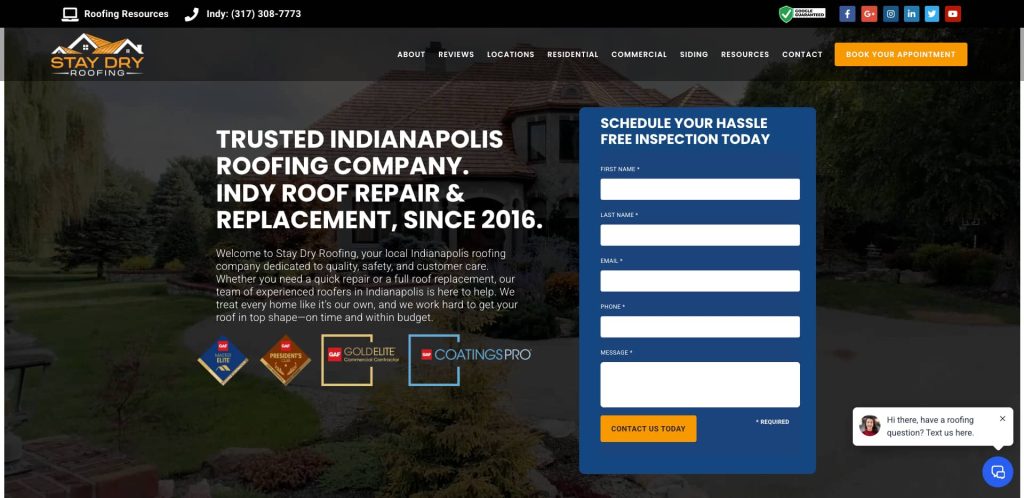
8. Stay Dry Roofing
Location: Philadelphia region
- ‘Back to top’ button and persistent appointment CTA enhance UX
- Clean layout with clear service categories and blog integration
- Strong site structure built around audience behavior
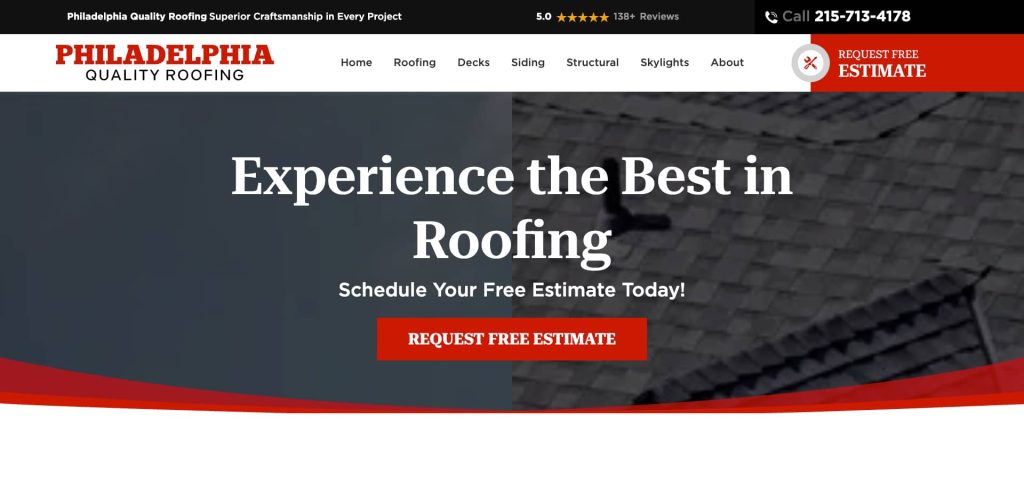
9. Philadelphia Quality Roofing
Location: Philadelphia, PA
- Scroll-triggered animations create engagement as users explore
- Carousel of reviews and project visuals keeps attention
- Dynamic layout encourages deeper browsing
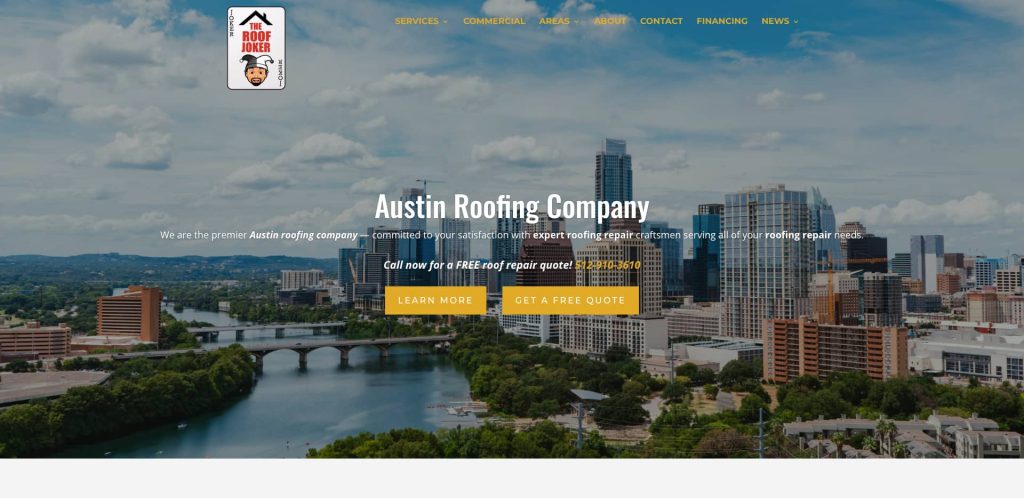
10. The Roof Joker
Location: Denver, CO region
- Heavy use of visuals and icons for quick comprehension
- Breaks text-heavy content with branded imagery and graphics
- Trust-building with a friendly, bold presentation
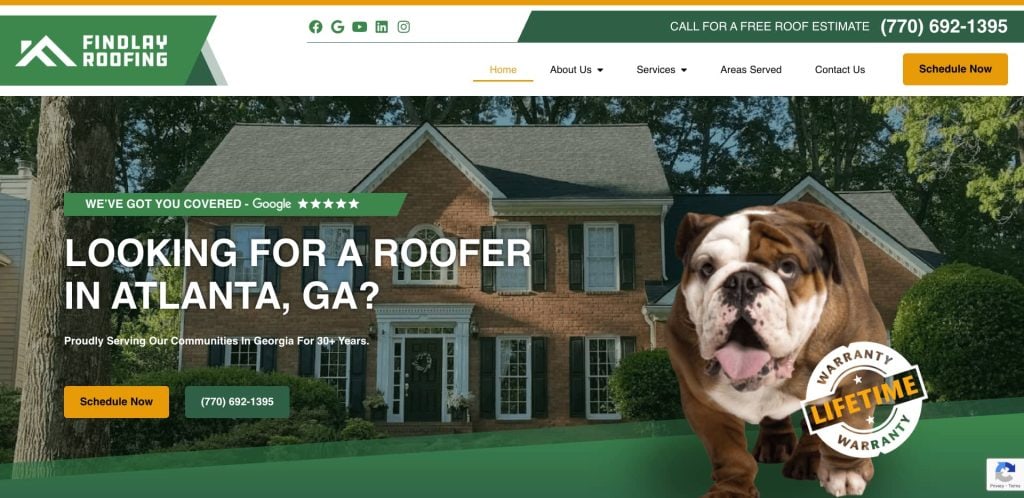
11. Findlay Roofing
Location: Ohio
- Fully responsive design adapts cleanly on mobile/tablet
- Thumb-friendly layout and easy navigation for mobile users
- Mobile-first UI supports fast lead capture and action
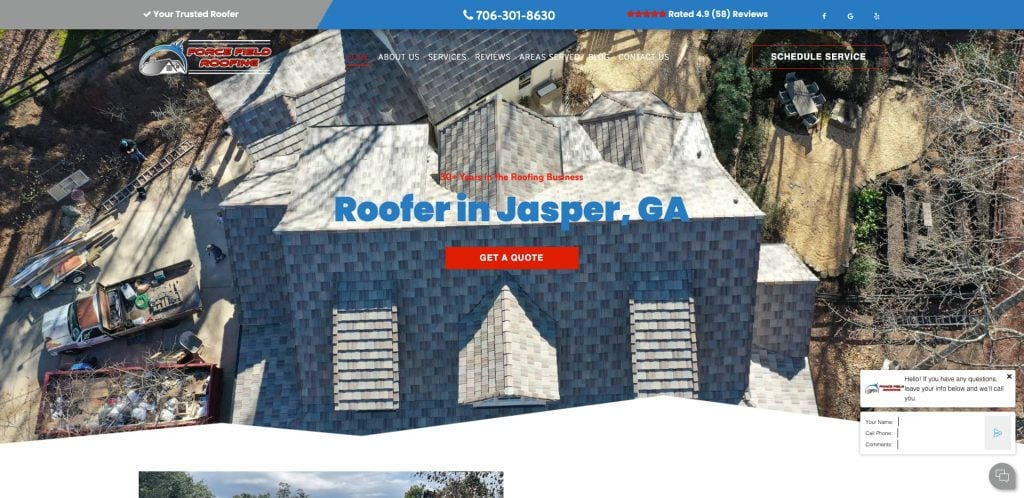
12. Force Field Roofing
Location: Midwest
- Simple, clear service buttons with geometric layout
- Clean navigation ensures quick access to conversion prompts
- Balanced design blends innovation with usability
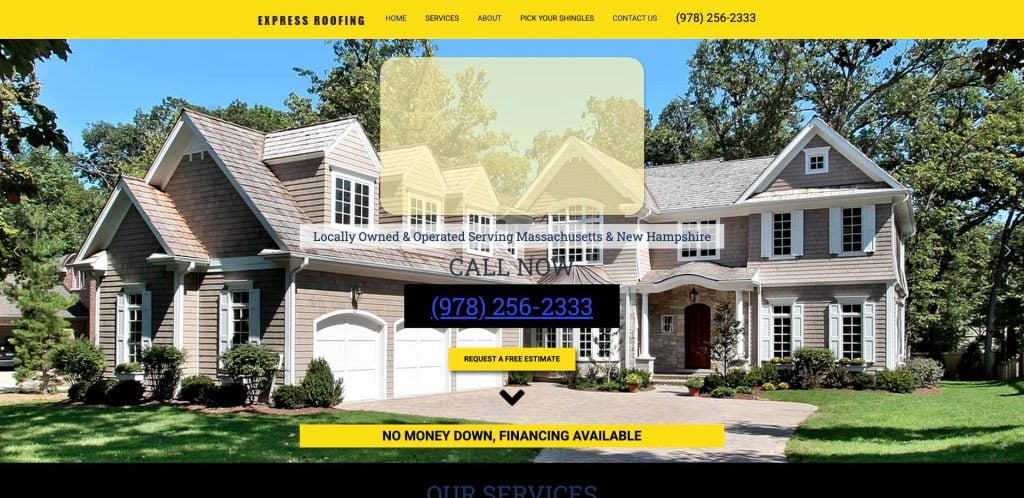
13. Express Roofing & Restoration
Location: Indianapolis, IN
- Calm color scheme creates trust and local comfort
- Minimalist navigation keeps focus on services and contact
- Consistency across pages fuels clarity and conversions
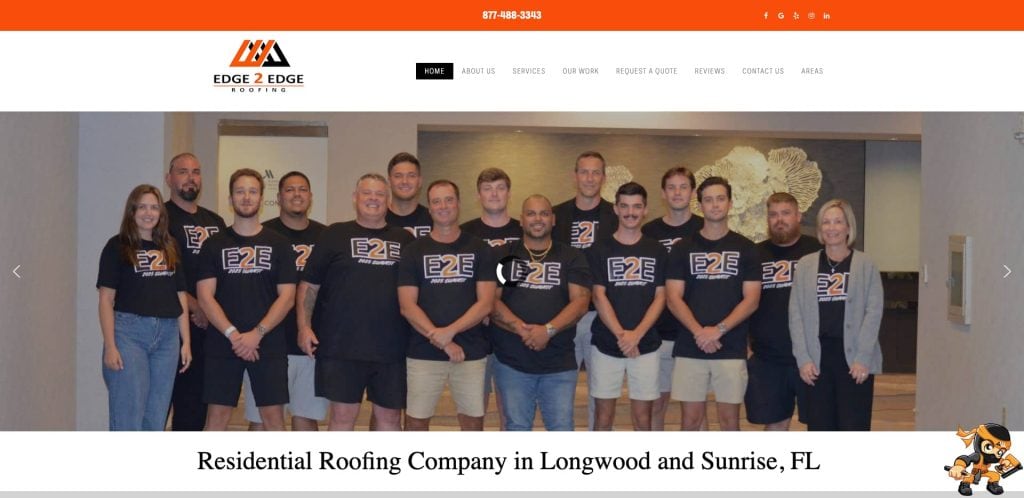
14. Edge 2 Edge Roofing
Location: Unknown U.S. city
- Owner/staff featured in hero image builds instant credibility
- Review widget in the footer paired with an accessible contact form
- Bold color accents elevate brand identity
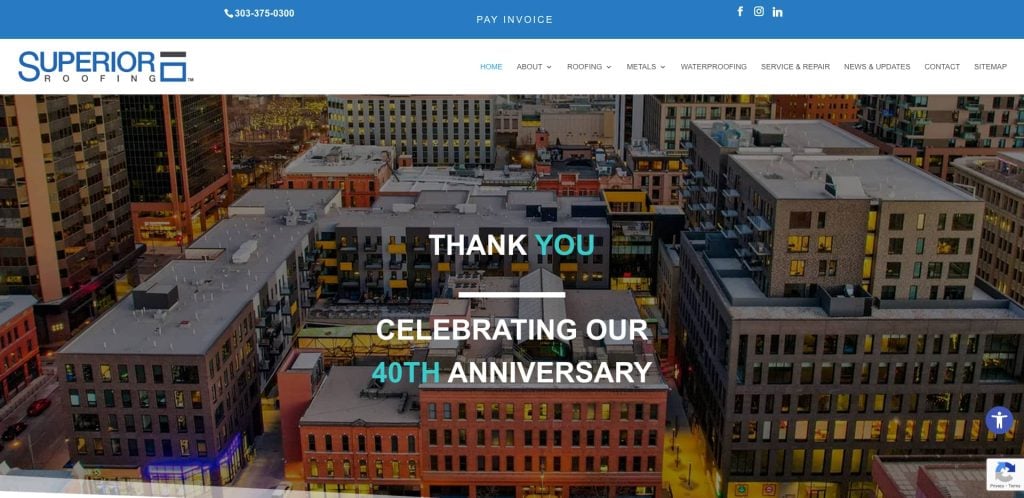
15. Superior Roofing
Location: Generic U.S. Region
- Clean template with boxed layout and whitespace for readability
- Service sections are well differentiated with icons and titles
- Structured design aligns content and CTAs effectively

16. Manhattan Roofing
Location: New York, NY
- Simple, organized header and homepage layout
- Contact form, map, phone, and email in the footer improve access
- Minimalist content keeps visitors focused
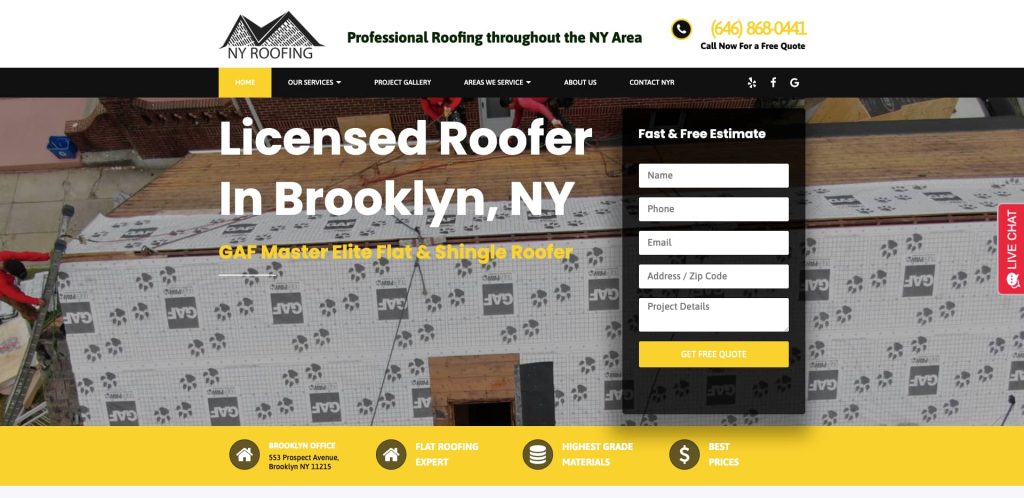
17. NY Roofing
Location: New York, NY
- Bright yellow/black palette draws attention to CTAs and offers
- Blog section adds SEO-rich, useful content to attract visitors
- Images contextualize services and the environment
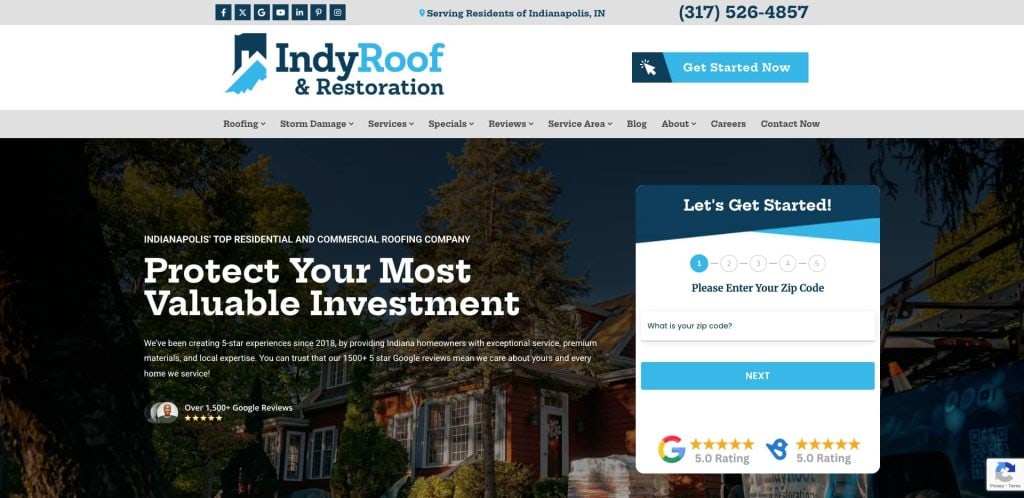
18. IndyRoof Company
Location: Indianapolis, IN
- Videos integrated throughout the homepage engage immediately
- Clear layout featuring contact info, social links, and blog
- Inforich content encourages exploration and trust
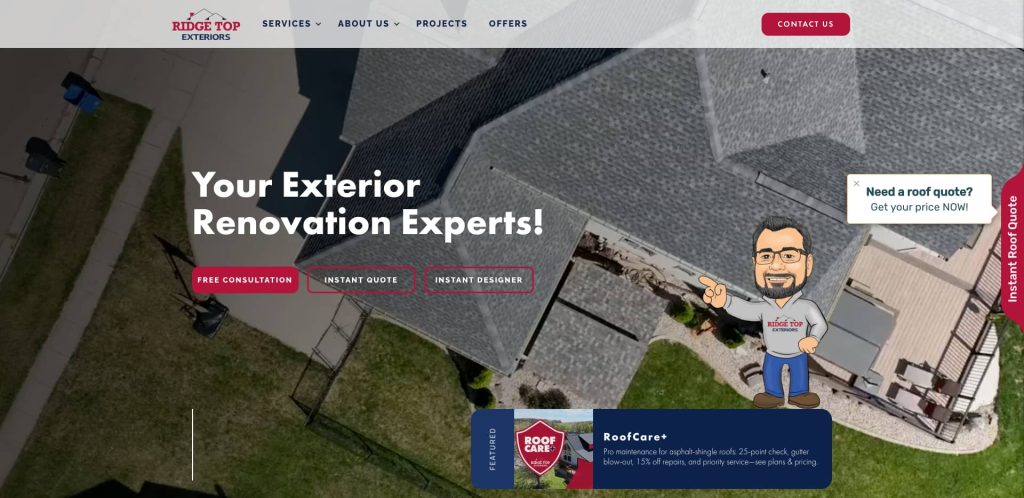
19. Ridge Top Exteriors
Location: Possibly Southeast U.S.
- Auto-playing video backdrop creates a dynamic first impression
- 3D models and animations communicate service complexity
- Testimonials and review integration reinforce authority
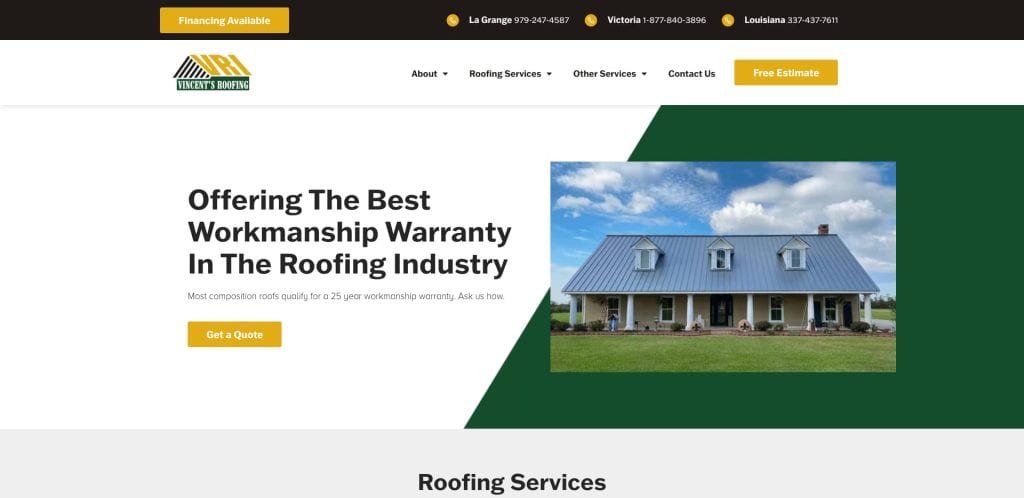
20. Vincent’s Roofing Inc.
Location: U.S. (regional)
- Modern, minimalist layout with ample white space and professionalism
- Responsive design ensures a seamless mobile experience across devices
- Uses striking completed-project imagery to showcase workmanship
Take the Next Step Toward a High-Performing Roofing Website
If you’re a roofing professional ready to grow your business online, the right website can be your most powerful asset. From attracting qualified leads to improving your visibility in local searches, every detail—from structure to visuals—plays a role in building a website that gets results.
At our full-service digital marketing agency, we specialize in web design for roofing companies that want more than just a good-looking homepage. Our team combines expert web design services, SEO best practices, and conversion-focused strategies to help your roofing company stand out, connect with your audience, and turn visitors into customers.
Whether you’re building your first website for your roofing business or revamping an outdated design, our team is here to help you build a roofing website that performs.
Let’s build something strong together. Request your custom web strategy today.
Frequently Asked Questions About Roofing Website Design
How do I create a successful roofing website that gets more leads?
To create a successful website, focus on user experience, mobile responsiveness, and fast load speeds. Include design features that showcase your best roofing projects, client testimonials, and trust signals like licenses and reviews. Clear calls to action like “Request a Free Estimate” or clickable phone numbers at the top of the page help drive conversions. Using targeted service pages that match the type of work you offer also increases website traffic and SEO visibility.
What should be included on my company homepage?
A homepage should highlight core services for roofing and construction, customer reviews, recent project images, and a strong call to action. It should also clearly reflect your brand and quickly communicate how you help those looking for roofing services. Make sure your website is mobile-friendly and that key navigation options are accessible near the top of the page.
Do I need to hire a web designer, or can I build my own website?
While you can build your own website using roofing website templates or choose a website builder, working with professional roofing web design experts will ensure your site meets industry standards and SEO best practices. A web designer can create a site that reflects your brand, enhances credibility, and helps with growing your roofing business long-term.
What are the best design features for roofing websites?
The best websites include before-and-after galleries, clear service breakdowns, online estimate forms, and visual indicators of trust like certifications. Make sure the design of your website includes prominent calls to action, service area targeting, and social proof. Including content in your roofing service areas helps with both user engagement and local SEO.
How do I track website performance for my roofing business?
You can track website performance by setting up tools like Google Analytics and Search Console. These platforms help monitor website traffic, user behavior, and keyword rankings. Tracking form submissions, calls from your site, and button clicks will show which areas of your website are converting.
How can custom site design services help with SEO?
Professional site design services go beyond visuals. A good web design and marketing strategy ensures your content aligns with what people are searching for in roofing services. Proper site structure, optimized content, internal linking, and fast load times all contribute to better rankings and more qualified traffic. A site built with SEO best practices will appear higher when people are searching for roofing services in your area.
What should I include in the service pages on my roofing website?
Each service page should target a specific type of roofing work you offer, such as residential, commercial, or storm damage repair. Include service descriptions, project photos, common questions, and a clear call to action. These pages allow you to build your roofing site’s authority and help search engines and visitors understand the full range of your services for roofing.
Should I use roofing website templates or custom design?
Templates are a quick start, but they often lack flexibility, SEO optimization, and differentiation. If you want a site that reflects your brand and stands out from other companies across your market, custom web design for roofing is the better route. It ensures your roofing web design project aligns with your unique offerings and customer expectations.
What are some common mistakes to avoid when designing your roofing website?
Common mistakes include using low-quality photos, burying contact information, slow page speeds, and not optimizing for mobile. Other issues involve generic content, a confusing layout, or not aligning with your roofing company’s local service areas. Always make sure your website is one that reinforces trust, ranks well, and converts.
How do I ensure my website is an opportunity to grow my business?
Treat your website as a digital salesperson. Incorporate strong design features, relevant content throughout the website, and targeted SEO. Showcase your roofing work, make contact easy, and build trust through social proof. Your website is an opportunity to generate leads, so it must represent your brand professionally and function as a tool for growing your roofing business.



